Stargazing

|
Orion & Taurus |

|
- For touring the winter sky, our telescopes are set up and then are
immediately trained directly on the Great Orion Nebula. So, now...
as we all stare off to the south... who sees something they recognize?
(Someone usually recognizes Orion.) This is the brightest constellation
in the sky. Orion is a great hunter and mortal enemy of Scorpius, the
Scorpion, which is why they are placed on opposite sides of the sky. In
the late Spring, as we watch the last of Orion disappearing over the
Western horizon, we can turn and watch the head of Scorpius peaking above
the Eastern skyline to check that the coast is clear. When one rises the
other sets, they are never seen together. {Trace out Orion, noting the
belt, one raised arm holding a club, the other outstretched holding a
pelt.}
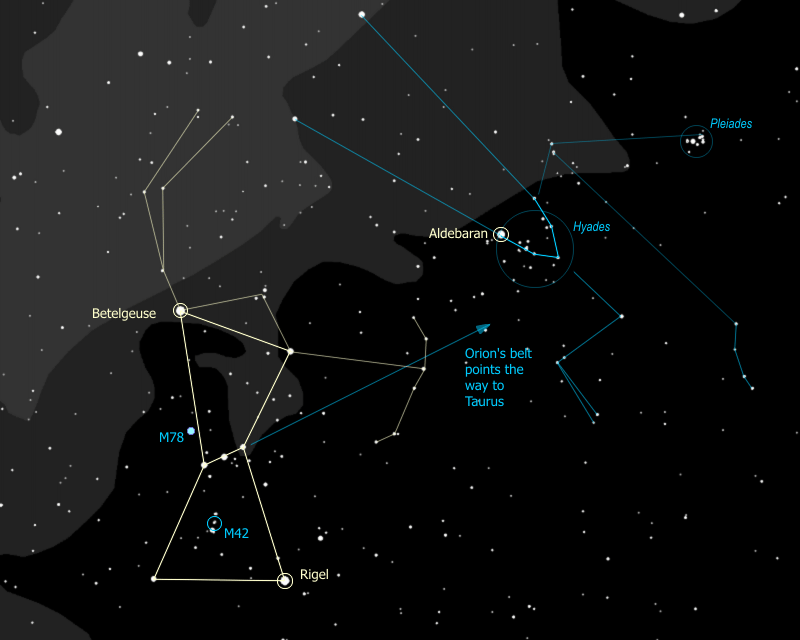
- The two brightest stars have their own names. The one at Orion's
shoulder, to your left, is Betelgeuse, pronounced "beetle juice", yes,
like the movie, and the one at Orion's knee, to your right, is Rigel.
Do you notice anything special about Betelgeuse? See how red this star is?
It is actually a red super-giant star. This star is enormous. Placed
where our sun is, the surface of Betelgeuse would reach to somewhere between
the orbits of Mars and Jupiter. It is so big that we have been able
to make an image of it and measure its diameter even though it is about
500 light years away.
There is only one other red super-giant that is this bright and it's on the opposite side of the sky, in the constellation that dominates the summer sky -- the star Antares in the constellation Scorpius. Both stars are about 500 ly away in opposite directions so we lie about halfway between the two. Such stars are rare -- there are only 200 known red super-giants and all are much dimmer, and therefore much farther away than these two stars.
- Notice that there's a sword that hangs from Orion's belt. See how the
tip of the sword gleams? That is not a trick of your eyes, there's
something there, more than just a few stars. You can see it through
binoculars, and you can see it better through the telescope.
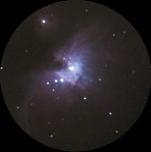
The Orion Nebula (M42) in a small telescope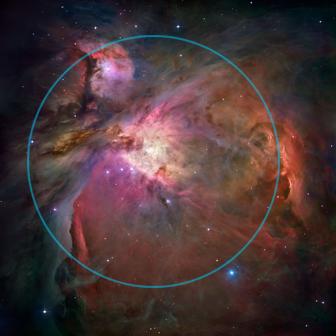
...and in the Hubble TelescopeThis is the Great Orion Nebula, also known as "M42". It is one of many "M" objects named after a catalog published in the late 1700's by the Frenchman Charles Messier. Messier was a comet hunter of great renown who published a catalog of fuzzy things that might be confused with comets. These ended up being some of the most interesting objects in the sky.
This region of the sky, Orion and its neighboring constellations, happens to be one that is dense with nebulae and young stars. The only other region of the sky with this much new-star formation activity is Sagittarius and its neighboring constellations.
This nebula is remarkably clear in a telescope, binoculars, or even to the fiercely concentrated eyeball. The longer you look, the more detail you can see. Notice in the telescope how the nebula forms the shape of a ghostly bat. Look very carefully at the bright star at the center of the nebula. It's not just one star, it is actually FOUR! In fact these four stars have a special name, they are called "The Trapezium". It is their energy that lights up the nebula.
The Great Orion Nebula is huge beyond comprehension -- what you are seeing is about 1500 light years away from us. The bright region you can see is about 5 or 6 light years across, however long-exposure photographs show that this nebula covers nearly the entire constellation of Orion!
Directly above M42, much smaller and almost touching, is another nebula, M43 (logically enough). A little above the two of them, a distance that's about the size of M42, is another nebula with the colorful name "NGC 1977". NGC stands for New General Catalog -- published in 1888 it's not really that new.
- There's another nebula called M78, on the eastern side of Orion just above
his waist. It's worth chasing down, and not too hard to capture in the
telescope -- on a good night we can see it in binoculars. This is the
brightest "reflection nebula" in the sky -- it is simply dust reflecting
the light of those two stars you see in it. The Orion nebula, by contrast,
is an emission nebula. The stars of the Trapezium are putting out such
high-energy radiation, the gas is glowing on its own, like a neon light.
M78 in Telescope What you're looking at 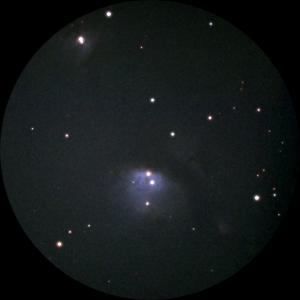
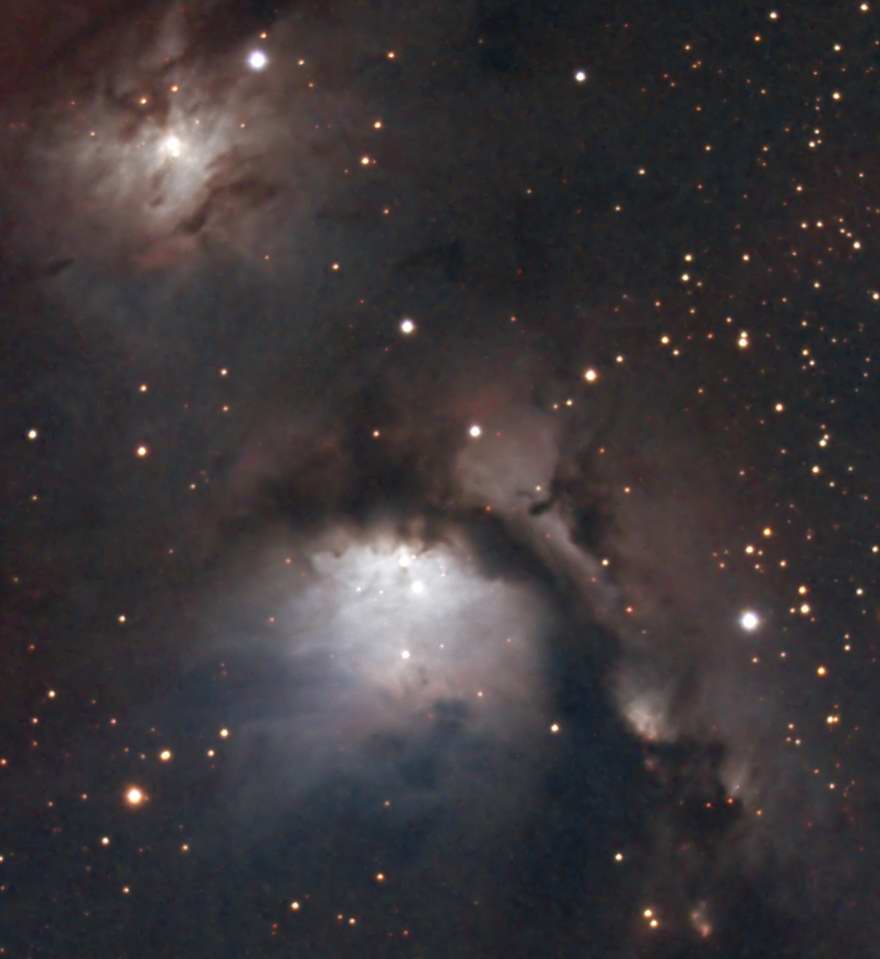
- You can extend the line of Orion's belt to the right
toward a "V" of stars nearby. This is the face of Taurus the Bull.
{Trace out Taurus, showing the face, the horns, and the two forelegs.}
Some people try to fit the whole bull into the stars that are the
legs and it comes out looking like something from a Picasso painting.
That very bright star on the top left corner of the "V" is Aldebaran,
pronounced "all-DEB-uh-ron".
- See that
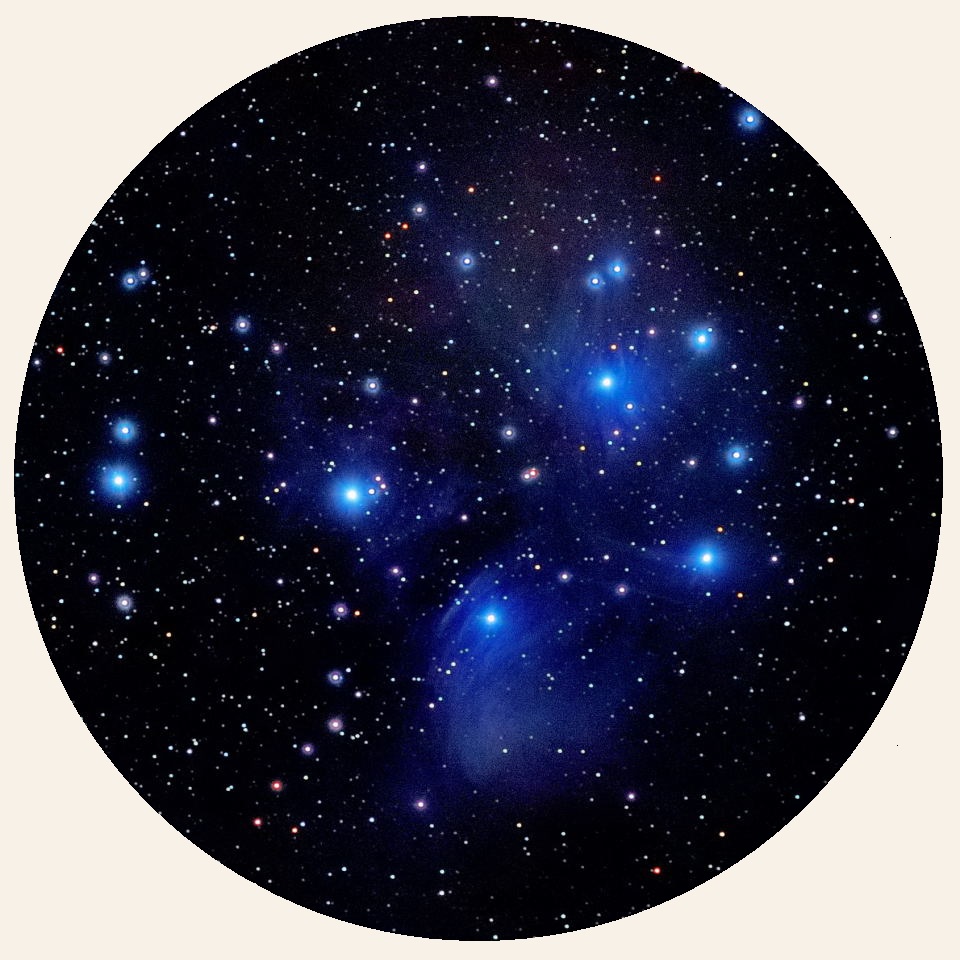 little cluster of stars right about where the
shoulder of the bull would be? That is the Pleiades, or the Seven Sisters.
Can you count seven stars just by looking? Some people see six, some see
seven. Actually you can find more than seven stars in binoculars and even
more in the telescope. The better you can see this exquisite star cluster,
the more beautiful it gets.
little cluster of stars right about where the
shoulder of the bull would be? That is the Pleiades, or the Seven Sisters.
Can you count seven stars just by looking? Some people see six, some see
seven. Actually you can find more than seven stars in binoculars and even
more in the telescope. The better you can see this exquisite star cluster,
the more beautiful it gets. This is a true "galactic cluster", meaning a group of stars all born out of the same cloud of gas. Sometimes these are called "open clusters". In photographs of the Pleiades you can still see traces of gas around the stars, remnants of the original nebula. The Pleiades lie 400 light years away from us, with a total of 500 stars in the cluster. Nine are so bright they have their own names.
- You want to see a star cluster that's three times closer than the
Pleiades? The "Hyades" cluster is only 130 light years away from us. So
where is the Hyades? It is the ENTIRE FACE OF THE BULL, with the notable
exception of Aldebaran. Part of the reason that Aldebaran is so much
brighter than the rest of the "V" is that it is only half as far away,
at 65 light years. You definitely want to get a look at the face of
Taurus in the binoculars. Wow, huh? The binoculars were worth bringing
along just for that alone.
Usually a star cluster looks like a tiny fuzz ball, but the Hyades appears to be a huge and distinct group of stars spread out over the sky because it's so close. Like the Pleiades, the group consists of about 400-500 stars total. Also like the Pleiades, this is a true galactic cluster, born from the same cloud of gas and all moving together in the same direction in space. They are moving away from us, toward Betelgeuse, and in 50 million years they'll be just another little fuzz ball near that star. So enjoy it now while you can. The Hyades is estimated to be about 400 million years old, making it a fairly old star group for an open cluster.
By comparison the Pleiades are much younger, at "only" 100 million years old. Galactic clusters usually are relatively young, since events conspire to break these groups up over time. The sun has long since left the nebula and cluster of its birth, travelling now through the galaxy alone, with only us to keep it company.
 |
 |
 |
| Back to the Winter Home Page | Go to Winter Index | On to Auriga |
Questions
Your questions and comments regarding the Stargazing section are welcome.
You can e-mail the author, Randy Culp for inquiries,
suggestions, new ideas or just to chat.
Updated 18 July 2023
